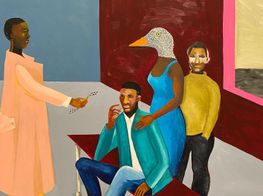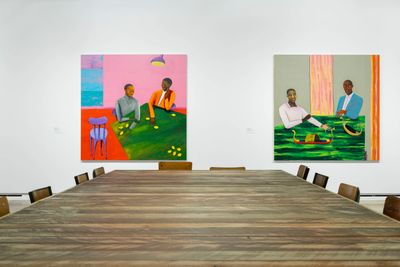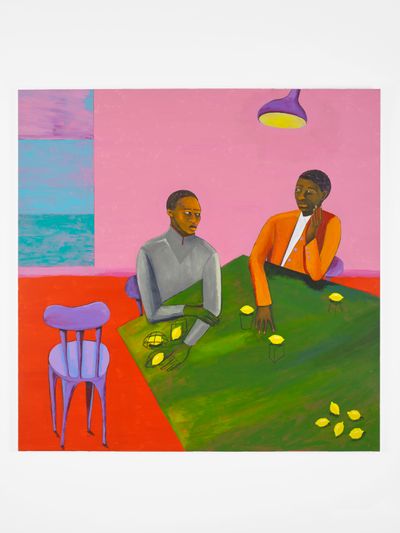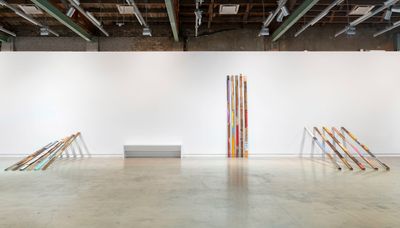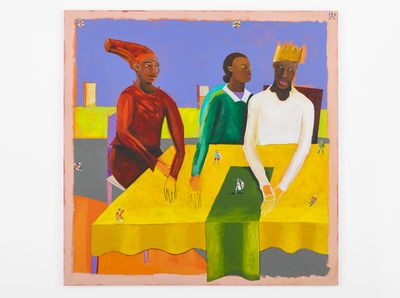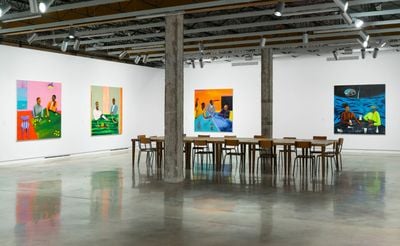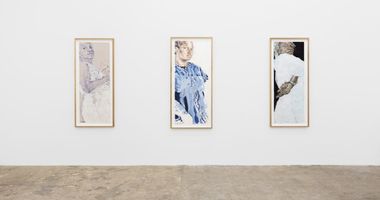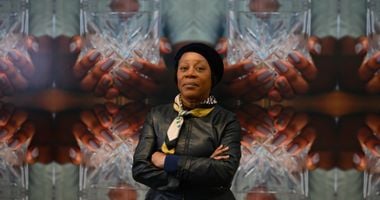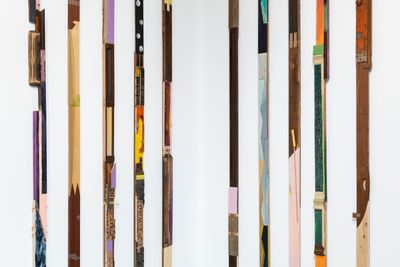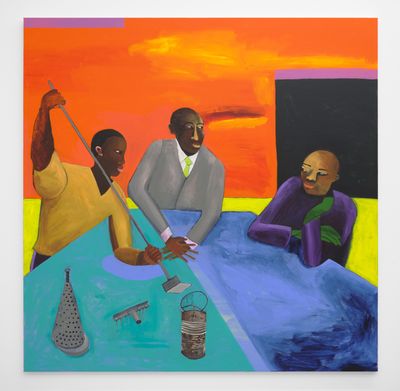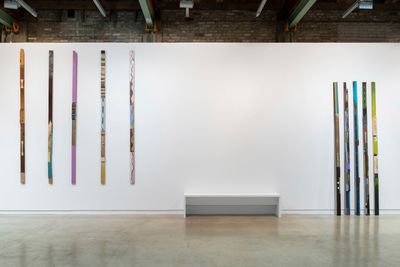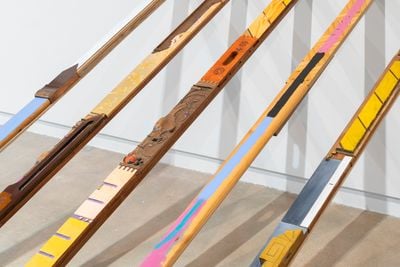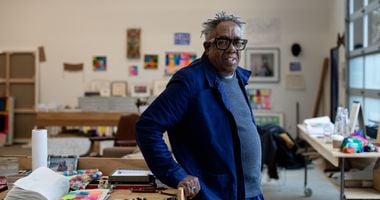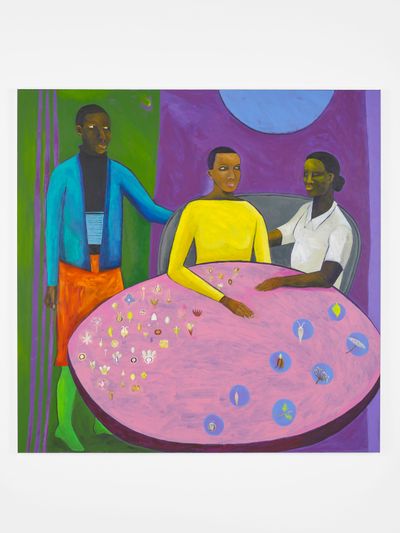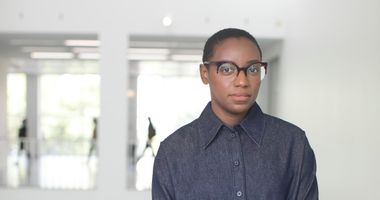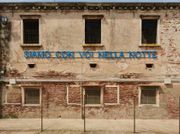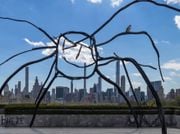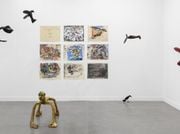Lubaina Himid on ‘Thinking, Feeling, and Holding Back’
Lubaina Himid. Photo: Magda Stawarska, Hollybush Gardens.
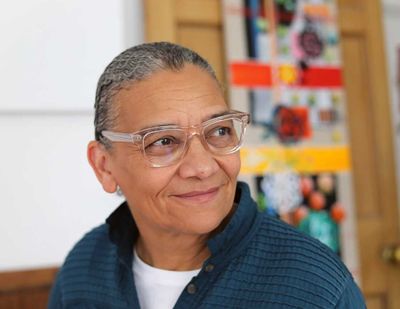
Lubaina Himid. Photo: Magda Stawarska, Hollybush Gardens.
Lubaina Himid became the first Black woman and oldest recipient of the Turner Prize in 2017.
Seven years on, she is the recipient of the 2024 Suzanne Deal Booth / FLAG Art Foundation Prize, with an accompanying exhibition titled Make Do and Mend at The Contemporary Austin in Texas, which will travel to New York later this year. It is recognition that is well-overdue for Himid, who has painted prolifically for over 40 years. But she isn't slowing down anytime soon.
Born in Zanzibar in 1954, Himid emigrated to the U.K. with her mother, a textile designer, that same year. She studied theatre design at Wimbledon College of Art in the seventies and graduated with an MA in cultural history from the Royal College of Art in 1984. Himid was a key contributor to the British Black arts movement of the 1980s, where young artists worked collectively to highlight issues of race, gender, and the ongoing impacts of coloniality, often exhibiting outside of mainstream institutions for their own communities. Its associates included Sonia Boyce, Keith Piper, and Claudette Johnson, among others. As Himid told Ocula Magazine, 'We were making work in a particular way where we didn't have to explain our identities.'
Himid's paintings, drawings, and prints make protagonists of ordinary people, centring them in narratives that have elided them. Her acrylic and charcoal 'Strategy Paintings' (2023), on view at The Contemporary Austin, depict seemingly quotidian interactions across ten different canvases.
In Bitter Battles (2023), for example, two men appear to solve a puzzle using lemons spread across a table. Their expressions of consternation and intrigue underscore an urgency made visible in their use of readily available objects. In Pointless Heroism (2023), two women converse with a man wearing a crown while an assortment of figurines, including one of Joan of Arc, sit scattered across the table before them like pawns in a strategy game. The issue of who gets to tell history appears at stake.
Make Do and Mend equally elevates Himid's installation works. With The Aunties (2023), an arrangement of 64 painted planks made of found wood, Himid invites audiences to think about the ways women have shaped and influenced their lives. Some planks rest vertically against the wall, while others jut out from the floor at dramatic angles, leading the viewer to negotiate their scale and elevation.
These two bodies of work debuting at The Contemporary Austin bring together themes that Himid has engaged throughout her career while also demonstrating continued experimentation with material and modes of installation. What remains constant is Himid's concern for interpersonal relationships, collaborative decision-making, and the centring of people who often sit at the peripheries of the mainstream.
In the following conversation with Neil Price, Himid discusses the impact of receiving prizes, being a part of the British Black arts movement of the 1980s, and the importance of calculation and holding back.
NPIn what way did winning the Turner Prize in 2017 change your career or the way you approach your work?
LHIt didn't change my artistic practice at all. I'd been working for 35 years without winning a prize or receiving that kind of recognition. When you've been doing something that long, you work when you want to, which is most of the time, and you have to be your own critic. You have to believe in the work for itself—you're not able to measure it up against anything except the last thing you made.
However, in terms of how many more people knew about my work, it changed things immensely. Through all those years, many audiences knew my work and a lot of art historians wrote about it. There have been books and essays on my work, which led to British curators developing knowledge of it. Even if they weren't necessarily showing it, they knew about it and understood what I was trying to do. But I wasn't a known entity amongst the general public or the media. My art seemed to come out of nowhere as far as they were concerned. The Turner Prize changed all of that.
NPYou've discussed your interest in how the audience engages with your work. It seems to me that you're intrigued by the interaction between the viewer's interior life or thoughts and how those are brought into conversation with your paintings. Could you tell me about that?
LHPersonally I've always tried to have that kind of engagement with paintings, particularly in historical museums. Sometimes I couldn't find myself in the paintings being shown. I felt I didn't belong in those paintings or the institutions that were showing them. Many artists are painting ourselves back into the history that we knew we belonged to, to fill those gaps, and show that we certainly were present hundreds of years before. We've always been a part of the cultural and political landscape.
I'm trying to express thinking, feeling, and waiting and holding back, so as not to take the power in the room in order to get the job done.
I'm reminded of what [the writer] Toni Morrison said about the importance of writing the kind of books you want to read. I'm trying to make the kinds of paintings I wanted to see exist, where Black people are centre-stage, where we are seen to be acting, deciding, and changing things. Where we are key protagonists—not adjuncts, nor the waiting staff; not the slave in the corner, nor the person who passes the gun to the general.
NPYou're reminding me that painters also comprise the audience.
LHAbsolutely. I'm always concerned with what audiences do for themselves after they leave the paintings. I want the viewer to feel the agency to go out there and do whatever it is they do in a different way or in a way that's better for them. I know that by looking at paintings and being with visual art for 60 years, those experiences have helped me try to find who I am, find peace or pleasure, or find out something about life I didn't know before.
All of these are paintings of a moment, in between a question and an answer.
NPI want to talk about the British Black arts movement. It seems to me that you and other Black women artists in the 1980s were supporting each other by showing each other's work in a way that was protective, collectively nourishing, and inward looking. There didn't seem to be a lot of insistence on showing in public galleries and institutions or caring about what mainstream audiences thought about the work. Would you agree with that reading?
LHThat's sort of accurate. In the beginning I was talking to and working with women like Claudette Johnson, Sonia Boyce, and Veronica Ryan, and we were concerned with showing our work. But we were not thinking about mainstream institutions. We were thinking about showing our work to other Black women. We were showing quite different kinds of work in art centres, where you might go in with one intention but end up doing something quite different.
The whole point for me was that we were all Black women but we were not coming from the same starting point. Some of us were born in Britain, others were from the Caribbean, some were born on either coast of Africa. Some of us had formal art training in Britain, others didn't. We were in no way monolithic. So it was very much about displaying the work, but the audience was us. We were making work in a particular way where we didn't have to explain our identities. We didn't have to explain ourselves. We could immediately talk about whatever subjects we were interested in.
NPIn your current exhibition Make Do and Mend at The Contemporary Austin, you're continuing to build on ideas you were working on in the installation Naming the Money (2004), where you created figurative paper cutouts to explore identity, naming, and what it meant to live with stories that are personal or that people ascribe to us. But for The Aunties (2023), an arrangement of 64 plank paintings, you moved away from figuration altogether. Could you discuss that choice?
LHOnce I've done a work like Naming the Money, I've done it. What I'm trying to do with The Aunties is get even more of that audience contribution we talked about. I want to leave space for the viewer to bring along or see their own aunty. These are women who play a key role in our lives, but it's not a mother role. It's very much a woman's role. Aunties are all kinds of different women with different experiences. I'm interested in opening up more possibility for visioning and remembering our encounters with these women.
NPIn your 'Strategy Paintings' (2023), you show characters in conversation in settings where various objects such as lemons, model ships, and loose teeth are displayed. When I look closely at the expressions on the subjects' faces, there seems to be a pervading sense of consternation.
LHAll of these are paintings of a moment, in between a question and an answer. And that moment is filled with everything in a sense. We're witnessing one person who has asked a question, and the other people are drifting off because they can't comprehend the question, or they're thinking incredibly deeply, saying, 'How on earth or am I going to answer this question?' Or they know the answer, but they know their response will swing the power in one direction or another.
In these paintings I'm trying to express thinking, feeling, and waiting and holding back, so as not to take the power in the room in order to get the job done. Because if you take the power, I might be inclined to draw back or attack. The people in the drawings have to calculate all of that, and I'm trying to capture that calculation.
NPI'm wondering about your process with respect to the questions we've discussed. Does it start with research before you move toward visualisation, or vice versa?
LHOver the years a lot of reading has happened, as well as a lot of looking at people and observing. There is also the reading and designing of plays, and looking at the history of art and what's represented in the history of European painting and what isn't represented. All of this is playing out as I work, and in some ways, these current paintings relate to work I did in the 1990s and early 2000s. Sometimes I revisit work because I thought I knew what I wanted to do back then, but now I have more knowledge that I can bring.
NPI know you don't like the idea of a retrospective because it's a backward way of looking.
LHMy Tate Modern show in 2021 was a survey, but I didn't permit the curator to hang the show chronologically. I'm interested in going backwards and forwards to re-think an idea. I'm not interested in a chronological presentation that tries to say, 'This is what she made in in 1972, and this is what she made in 1982.' That's not how artists work.
NPYou've talked about the experience of collaborating with others to create works for this exhibition in Austin. Is this a recent shift in your practice?
LHIn some ways it is. Over the past ten years the artist Tao Lashley-Burnley has always helped me if I want to do something in a particular way. But this is the first time my team has actually been involved in making the work, which has been a good experience. At the beginning of the process, there were some challenges because I didn't explain exactly what I wanted. You assume that the team knows what they're doing. I've learned that if I say what I want, then they feel comfortable having the freedom to do it. And the materials were from my studio or purchased from secondhand dealers who are friends of ours, so that meant I was always involved and knew what the pieces were made from.
NPI want to talk about late-career recognition. I've spoken with other artists who have told me that, in some ways, it was a blessing because when no one is showing a tonne of interest in your work, you're free to practice without interference or anyone suggesting what might sell.
LHThat's true. Certainly I was able to spend at least from 1976 until 2017 doing whatever I wanted to do. No one was saying, 'I want more of these.' But since 2017, I'm still absolutely making what I want to make. I'm represented by two galleries, Greene Naftali in New York and Hollybush Gardens in London. I am with them because even if they might want me to make paintings that people want to buy, they don't say it [laughs].
NPI'm curious about your experience in Austin since winning the 2024 Suzanne Deal Booth / FLAG Art Foundation Prize.
LHInstalling the exhibition was the third time I've come to Austin. I'd come earlier because I needed to understand both the people and the place that had given me the prize. I also wanted to have a practical understanding of the exhibition space. When I arrived at the gallery, I was really intrigued. I really loved it because it's not just a white cube space; it's got loads of history and isn't just a neutral box.
By the second time I visited, I learned a lot more about where the gallery building stood in relation to the capital and what that proximity meant. I began to have a better sense of how the work could have a place in a city of talking and decision-making. I also realised how friendly and open the people in Austin are.
NPDid you have any preconceived notions about Texas?
LHNot really—the challenge was that I didn't know enough. For example, I really didn't understand how enormous Texas was! Also, I think I've come to understand that when Texans are interested in cultural things, they really go deep and are committed for a lifetime and bring vast amounts of money to it. I'm not sure I understood that prior to coming here. All sorts of things revealed themselves, rather than me anticipating how it was going to be. —[O]

